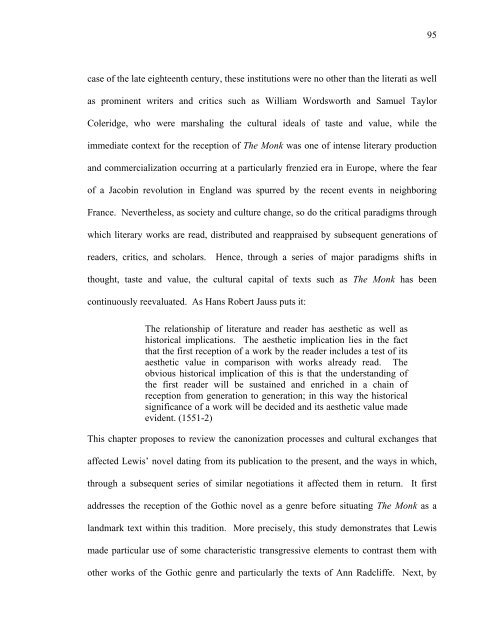Untitled - Sexey's School Moodle
Untitled - Sexey's School Moodle
Untitled - Sexey's School Moodle
You also want an ePaper? Increase the reach of your titles
YUMPU automatically turns print PDFs into web optimized ePapers that Google loves.
case of the late eighteenth century, these institutions were no other than the literati as well<br />
as prominent writers and critics such as William Wordsworth and Samuel Taylor<br />
Coleridge, who were marshaling the cultural ideals of taste and value, while the<br />
immediate context for the reception of The Monk was one of intense literary production<br />
and commercialization occurring at a particularly frenzied era in Europe, where the fear<br />
of a Jacobin revolution in England was spurred by the recent events in neighboring<br />
France. Nevertheless, as society and culture change, so do the critical paradigms through<br />
which literary works are read, distributed and reappraised by subsequent generations of<br />
readers, critics, and scholars. Hence, through a series of major paradigms shifts in<br />
thought, taste and value, the cultural capital of texts such as The Monk has been<br />
continuously reevaluated. As Hans Robert Jauss puts it:<br />
The relationship of literature and reader has aesthetic as well as<br />
historical implications. The aesthetic implication lies in the fact<br />
that the first reception of a work by the reader includes a test of its<br />
aesthetic value in comparison with works already read. The<br />
obvious historical implication of this is that the understanding of<br />
the first reader will be sustained and enriched in a chain of<br />
reception from generation to generation; in this way the historical<br />
significance of a work will be decided and its aesthetic value made<br />
evident. (1551-2)<br />
This chapter proposes to review the canonization processes and cultural exchanges that<br />
affected Lewis’ novel dating from its publication to the present, and the ways in which,<br />
through a subsequent series of similar negotiations it affected them in return. It first<br />
addresses the reception of the Gothic novel as a genre before situating The Monk as a<br />
landmark text within this tradition. More precisely, this study demonstrates that Lewis<br />
made particular use of some characteristic transgressive elements to contrast them with<br />
other works of the Gothic genre and particularly the texts of Ann Radcliffe. Next, by<br />
95



